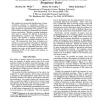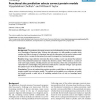294 search results - page 7 / 59 » Predicting the beta-helix fold from protein sequence data |
BMCBI
2006
13 years 7 months ago
2006
Background: Proteins that are similar in sequence or structure may perform different functions in nature. In such cases, function cannot be inferred from sequence or structural si...
BMCBI
2006
13 years 7 months ago
2006
Background: We describe Distill, a suite of servers for the prediction of protein structural features: secondary structure; relative solvent accessibility; contact density; backbo...
ISMB
1993
13 years 8 months ago
1993
Weconsider tile automatedidentification of transmembrane domains in membrane protein sequences. 324 proteins (containing 1585 segrrmnts) werc examined, representing every protein ...
BMCBI
2008
13 years 7 months ago
2008
Background: The prediction of protein structure can be facilitated by the use of constraints based on a knowledge of functional sites. Without this information it is still possibl...
BMCBI
2005
13 years 7 months ago
2005
Background: The sequencing of the human genome has enabled us to access a comprehensive list of genes (both experimental and predicted) for further analysis. While a majority of t...


